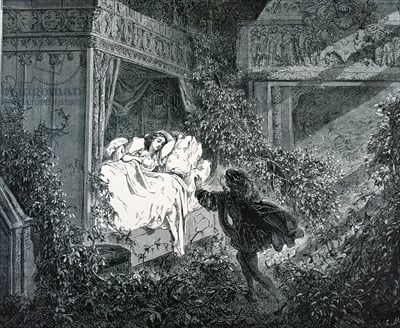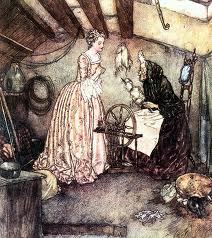With Richard Gill’s Sleeping Beauty pantomime about to hit the stage for the Victorian Opera, the State Library of Victoria’s Children’s Research Librarian, Juliet O’Conor, takes us through the history of this evergreen tale:
The story of Sleeping Beauty dates back to the 14th century and over time has been reshaped into widely disparate adaptations, from the sanitized to the erotic. The best known are the literary fairy tales of Charles Perrault, Histories ou Contes du Temps (1697), and a version called Little Briar Rose in the Grimm Brothers collection, Children’s and Household Tales, published in English in 1812.
The basic story describes how a number of wise women or fairies, seven in Perrault and twelve in the Grimms’ version, are invited by the king and queen to celebrate the much anticipated birth of their daughter. In both versions one fairy is excluded from the celebration. Angry about being ignored by the King and Queen, this wicked fairy appears at the celebration and curses the infant princess. When the princess becomes an adolescent she finds an old woman spinning, a practice banned from the palace because of the wicked fairy’s curse. Curious about the spinning process, the princess pricks her finger on the spinning wheel and falls asleep for one hundred years. During this time an impenetrable briar rose grows around the castle where she sleeps.
The Grimm brothers adapted their tales to fit the middle class morals of early nineteenth century German society. Their versions have been criticised by feminists for advocating patriarchal values and gender roles. In their Little Briar Rose, the princess wakes after the prince’s kiss and the tale simply concludes there, with an implied happy ending. In contrast, the earlier Perrault version describes how the prince impregnates the sleeping princess and she later gives birth to twins. The princess awakens when one of the babies sucks her finger and the piece of flax that keeps her asleep is dislodged. This dark scenario continues when the prince’s evil mother threatens to cook and eat the twins.
Unravelling the symbolism in fairy tales depends on the version studied. Some critiques suggest that Sleeping Beauty is a cautionary tale, with the number of fairies referring to the months or seasons of a year, the blood spilt by the princess when she pricks her finger being analogous with adolescent menstruation, and the heroine’s helplessness a representation of adolescent passivity. Feminists decry the application of patriarchal ideals of passivity, helplessness and innocent beauty to grown women.
You can find out more about the history and interpretation of fairy tales at the State Library of Victoria .




